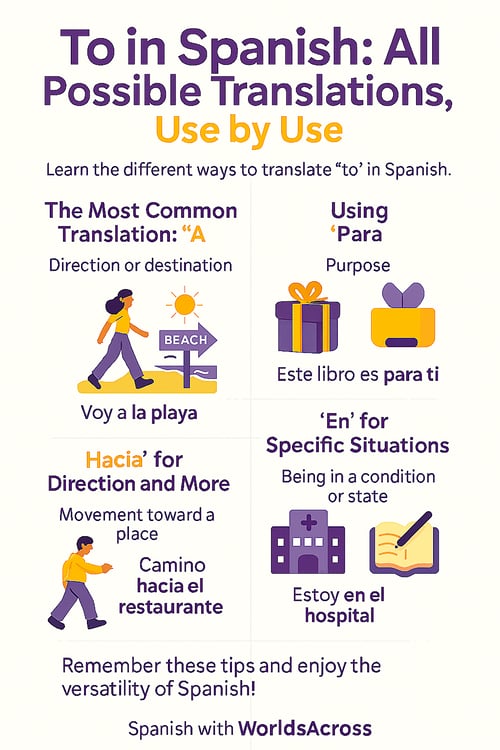To in Spanish: All the possible translations, use by use
Learning a new language is like discovering a new flavor. Each word has its own unique touch, and in this case, we’re going to savor the versatility of the word “to.” In English, “to” seems simple, but in Spanish, it’s a feast of translations! Get ready to explore the different ways to translate “to” in Spanish, in a fun and entertaining way.
The Most Common Translation: “A”
The first and most popular translation of “to” in Spanish is “a.” This little preposition packs a punch and is used in various situations:
- Direction or Destination:
Voy a la playa (I am going to the beach)
Here, “to” tells us where we’re going. This is a great example of how to say “to” in Spanish when talking about physical movement. - Time:
La película empieza a las ocho (The movie starts at eight)
“To” is translated as “a” when talking about time. Don’t be late! Remember to translate “to” this way in Spanish so you don’t miss important events. - With Verbs of Movement:
Ella camina a la escuela (She walks to school)
In this case, translating “to” as “a” clearly shows the action’s destination.
Using “Para”
Another common translation of “to” is “para.” This preposition is key to making intentions and purposes clear:
- Purpose:
Este libro es para ti (This book is for you)
Here, “to” becomes “para,” indicating something is intended or directed at a person for a specific purpose. - Goal or Aim:
Hago ejercicio para mantenerme saludable (I exercise to stay healthy)
We use “para” to explain why we do something—another example of how to translate “to” in Spanish when talking about purpose. - Deadline or Date:
Este proyecto es para el lunes (This project is due on Monday)
Here, “to” is translated as “para” to indicate a deadline.
“Hacia” for Direction and More
“Hacia” can also be used as a translation of “to,” especially when talking about movement toward a place:
- Movement Toward a Place:
Caminó hacia el restaurante (He walked to the restaurant)
Here, “hacia” indicates direction with a bit of elegance, a more sophisticated way of translating “to” in Spanish. - Attitudes or Feelings:
Ella tiene una gran actitud hacia la vida (She has a great attitude to life)
In this case, “hacia” expresses a more emotional relationship. - Abstract Destination:
Estamos avanzando hacia una solución definitiva (We are moving toward a definitive solution.)
In this sentence, "hacia" conveys the idea of moving toward a concrete goal or abstract destination.
“En” for Specific Situations
In certain contexts, “to” is translated as “en.” This translation may seem confusing, but it’s helpful in various situations:
- Being in a Condition or State:
Fue ingresada en el hospital (She was admitted to the hospital)
In this example, using "en" as a translation of "to" works well when discussing specific locations, events, or conditions. - Descriptions of Membership or Belonging:
Ella fue aceptada en el equipo (She was accepted to the team)
Here, “to” is translated as “en” when referring to someone joining a group—another interesting way to translate “to” in Spanish.
“To” in Specific Contexts
Finally, “a” also appears in more specific contexts. Don’t lose focus—here comes the interesting part!
- Infinitive Constructions:
Voy a aprender español (I’m going to learn Spanish)
Here, “a” is used to form the near future. It’s essential to know how to say “to” in Spanish in these structures to express your plans accurately. - Immediate Future:
Estoy a punto de salir (I’m about to leave)
“A” is used to express that something is about to happen.

Now that you’ve explored the various ways to translate "to" in Spanish, you have a valuable resource to improve your language skills. Each translation, whether "a," "para," "hacia," or "en," has its own place and function. So, when you speak or write, remember how to say "to" in Spanish and enjoy playing with these words.
Spanish is a true treasure of versatility. With its nuances and unique expressions, it offers endless ways to communicate and express ideas. At WorldsAcross, we’ll show you all the variations and ways to speak it, from casual to formal, so you can confidently navigate any situation. Our goal is to guide you every step of the way, helping you discover the richness of Spanish in a clear and effective way—no complications, and always with a touch of fun.



